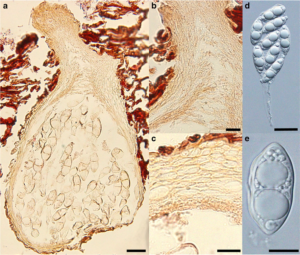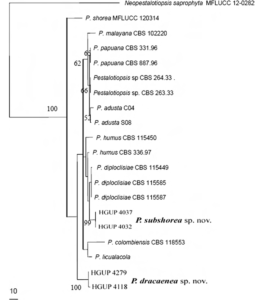Tinhaudeus formosanus K.L. Pang, S.Y. Guo & E.B.G. Jones, in Ariyawansa et al., Fungal Diversity 75: 164 (2015)
Index Fungorum number: IF 812937; MycoBank number: MB 812937; Facesoffungi number: FoF 00981; (Fig. 1)
Holotype – F28727 (National Museum of Natural Science,Taiwan)
Etymology – In reference to Taiwan where the holotype was collected.
Saprobic on decaying mangrove wood. Sexual morph: Ascomata 211-(295)-442×114-(180)-263 μm (n=6), lightto dark-coloured when mature, globose to subglobose, solitary or gregarious, immersed, coriaceous, ostiolate. Necks 104-(141)-174 μm long, 38-(64)-80 μm diam. (n=2), periphysate. Peridium 7-(15)-31 μm (n=6), composed of one layer of elongate cells with large lumina of textura angularis. Catenophyses present, persistent. Asci 133-(159)- 181×32-(39)-49 μm (n=15), clavate, unitunicate, 8-spored, thin-walled, persistent, with a long stalk, developing from inner wall of ascoma base, with a slightly thickened apex, plasmalemma retracted. Ascospores 26-(33)-38×10-(12)- 14 μm (n=61), ellipsoidal, hyaline, 1-septate, not or slightly constricted at the septum. Appendages bipolar, initially adpressed to the ascospore wall and extended over the midseptum, unravelling immediately in sea water to form a long thin filament. Asexual morph: Undetermined.
Material examined – TAIWAN, Chunan, on a piece of decaying mangrove wood, 27 January 2011, Ka-Lai Pang, F28727 (National Museum of Natural Science, Taiwan, holotype); ex-type living culture, BCRC FU30496 (Fig. 2).

Fig. 1 Tinhaudeus formosanus (holotype) a Immersed ascoma with neck protruding to the surface b Periphysate neck c One-layered peridium of elongated cells with large lumina d Clavate ascus e Ascospores with bipolar unfurling appendages. Scale bars: a–c, e=10 μm, d=30 μm

Fig. 2 Phylogenetic tree for Pestalotiopsis based on combined sequences of ITS, β-tubulin and EF by Maximum Likelihood (ML) method on MEGA 6.0. Bootstrap support values <50 % were not shown. The tree is rooted with Neopestalotiopsis saprophyta (MFLUCC 12-0282)
